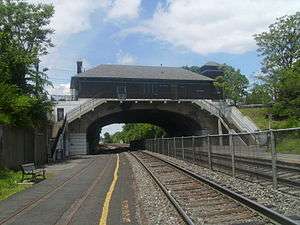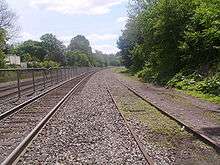Kingsland station
Kingsland | |||||||||||||||||||||
|---|---|---|---|---|---|---|---|---|---|---|---|---|---|---|---|---|---|---|---|---|---|
 Kingsland station facing northbound (towards Suffern) on the Hoboken-bound platform, with the station depot and Route 17 crossing overhead. | |||||||||||||||||||||
| Coordinates | 40°48′36″N 74°07′02″W / 40.8101°N 74.1172°WCoordinates: 40°48′36″N 74°07′02″W / 40.8101°N 74.1172°W | ||||||||||||||||||||
| Owned by | New Jersey Transit | ||||||||||||||||||||
| Line(s) | |||||||||||||||||||||
| Platforms | 2 side platforms | ||||||||||||||||||||
| Tracks | 3 | ||||||||||||||||||||
| Connections | NJT Bus: 76 | ||||||||||||||||||||
| Construction | |||||||||||||||||||||
| Platform levels | 1 | ||||||||||||||||||||
| Parking | 19 spaces | ||||||||||||||||||||
| Other information | |||||||||||||||||||||
| Fare zone | 2 | ||||||||||||||||||||
| History | |||||||||||||||||||||
| Opened | 1903[1] | ||||||||||||||||||||
| Traffic | |||||||||||||||||||||
| Passengers (2012) | 453 (average weekday)[2] | ||||||||||||||||||||
| Services | |||||||||||||||||||||
| |||||||||||||||||||||
Kingsland is a railroad station on New Jersey Transit's Main Line. It is located under Ridge Road (Route 17) between New York and Valley Brook Avenues in Lyndhurst, New Jersey, and is one of two stations in Lyndhurst. The station is not staffed, and passengers use ticket vending machines (TVMs) located at street level to purchase tickets. The station is not handicapped-accessible. Originally part of the Delaware, Lackawanna and Western Railroad's Boonton Branch, Kingsland station was built in 1903.
Station layout and services
| ■ Main Line | toward Suffern (Lyndhurst) | |
| ■ Port Jervis Line | no stop | |
| ■ Main Line | toward Hoboken (Secaucus Junction) | |
| ■ Port Jervis Line | no stop |
Kingsland Station is located on a bridge over the Main Line on New Jersey Route 17, near the intersection with Milton Road. The station depot is located above the tracks. A short tunnel leads downstairs to the two side platforms. The station platform on the Hoboken Terminal-bound side has a third track that heads through the platform, the western leg of a wye used for the Harrison Cut-Off, built by the Delaware, Lackawanna and Western Railroad. Above ground, the station is provided with just nineteen parking spaces, none designated for the handicapped. There is no fee for parking. Short-term parking is also provided by New Jersey Transit on Route 17.[3]
The station is serviced by New Jersey Transit's Main Line every day and has connections via Route 76 run by New Jersey Transit Bus Operations. On weekdays, the first train to serve the Kingsland station heads to Hoboken Terminal, stopping at 5:41 AM, while the last is Train #1101 heading to Suffern, stopping at Kingsland at 1:48 the next morning. Trains from Kingsland to Hoboken average 20 minutes and Kingsland to Suffern averages 55 minutes. On weekends, the first train to serve Kingsland, starting in Port Jervis, and stopping at Kingsland at 6:59 AM. The last train, to Suffern, arrives at 1:48 AM the next morning.[4]
History
Delaware, Lackawanna and Western Railroad

The Boonton Branch of the Delaware, Lackawanna and Western Railroad was first constructed as a freight bypass of the Morris & Essex Railroad in 1868. This was constructed due to the lack of freight along its passenger lines and stretched from the Denville station to Hoboken Terminal via Boonton and Paterson. The line had shops at Kingsland, built in 1868 for the purpose of repairing, restoring and re-erecting train cars and locomotives for the line. In 1875, shop equipment from Hoboken was moved over to Kingsland. However, just seven years later, the machine shop, also the main building of the shops, caught fire and was completely destroyed. However, despite the fire, the structure was immediately reconstructed for use. During this time, the Delaware, Lackawanna and Western used a small house as a station depot.[5]
When the Delaware, Lackawanna and Western expanded the Kingsland Shops in 1903,[6] a new station depot was constructed of brick along with a cut and cover tunnel. The tunnel itself cost $71,500 (1903 USD) and permitted the local street, Schuyler Avenue to cross over the rail line. The new station depot was built on Ridge Road over the tracks, with platforms crossing over the new bridge. The design of the station depot located above the tracks was later replicated by the Delaware, Lackawanna and Western's Montclair Branch for its Watsessing Avenue station in Bloomfield, New Jersey.[1]
In 1917, the railroad was brought before the New Jersey Board of Public Utility Commissioners due to an accident on November 28, 1916, at Kingsland station. Passenger train No. 582, a special train for employees of the Canadian Car Company, had near stopped at Kingsland station. The train never left at any defined time, although averaged around 6:30 in the evening. However, around 6:30that evening, Train No. 479 came in twelve minutes late at a high rate of speed, and as a result could not slow down fast enough to avoid hitting passengers. At that time, the station had no inter-track fencing to prevent crossing of both Boonton Branch tracks, and because of this, people could board trains from either platform. That day the engineer of Train No. 479 was unable to see the platform or the special train, and due to the lack of signals, had no information until the train knowing anything until the train left the west portal of Kingsland Tunnel. However, signals were set for west-bound trains if problems were to occur. After the accident, the Board requested the Lackawanna to install a westbound signal to prevent further accidents, while the Canadian Car Company moved its boarding to the company's rail siding.[7]
Erie–Lackawanna Railroad and the Passaic Plan
After several years of sharing railroad facilities, the Erie Railroad and Delaware, Lackawanna and Western Railroad merged on October 17, 1960, replaced by the Erie-Lackawanna Railway. Since 1949 the Erie Railroad had been dealing with the city of Passaic, New Jersey about its double track mainline through the city via Rutherford.[8] Due to the high cost of removing the main line with no back-up service, it was unable to progress forward, and as a result, the Erie built some new stations to replace old wooden ones in 1952.[9] With the railroad merger in 1960, the Erie–Lackawanna had the Boonton Branch that also served Passaic, and on August 23, 1960, with pressure from the New Jersey Department of Transportation to go ahead with it, a deal was struck between the city of Passaic and the railroad.[10] A new connection was to be made via the Erie's old Newark Branch to connect the Boonton Branch to the old Erie main at South Paterson. The old Erie main line through Passaic was abandoned at a ceremony on April 2, 1963, when service was terminated and service. Trains were re-routed via a "new" main line, using the Boonton Branch from Kingsland to Athenia.[1]
The remainder of the Boonton Branch was steadily decommissioned through 1963, as the New Jersey Department of Transportation requested the Boonton Branch's alignment through Paterson as part of Interstate 80 and New Jersey Route 21 through Passaic near BE Drawbridge and the Passaic Park station. This was turned over to the Department of Transportation on October 27, 1963, after a connection was constructed at Mountain View to the Erie's former New York and Greenwood Lake Railroad. The stretch from Paterson Junction to Totowa, including the Paterson High Bridge built in 1902, was abandoned and soon dismantled.[1] However, despite the changes, the Erie–Lackawanna continued to lose strength and in 1975, agreed to become part of the Consolidated Rail Corporation, dubbed Conrail, effective April 1, 1976.[9]
New Jersey Transit
In January 1983, Consolidated Rail Corporation handed over operation of the commuter railroads to New Jersey Transit Rail Operations.[11] On September 20, 2002, as part of the Montclair Connection, merging the Montclair Branch and Boonton Line, the Arlington station in Kearny was closed, resulting in the lack of a station in Kearny. As a result, a rail shuttle bus was created by the town of Kearny to bus passengers from Arlington station up to Kingsland via Route 76 bus route, giving rail passenger service to New York Penn Station and Hoboken Terminal. Shuttle buses were aligned at that time with the 5:02 AM, 6:03 PM and 7:08 PM. Services were adjusted for the timetable services on September 30, 2002.[12]
On June 22, 2010, the town of Lyndhurst put forward a proposal to buy the station depots at both Kingsland and Lyndhurst stations. The mayor of Lyndhurst, Richard DiLascio, said that the stations have seen better days and New Jersey Transit has no interest in renovating both buildings. Design plans for Kingsland station look towards a new coffee shop, after repairing and renovating the building. The station would also be converted from its old subway tile to a newer retro look for the building, paid for by leasing the building. Because an average of 440 to over 1,000 people use the Kingsland station daily, it would look better for the town of Lyndhurst to make a good impression on the riders.[13] Asof 2012, the station house was unoccupied. The town of Lyndhurst has requested that NJT lease the building to the municipality so that it might be renovated and brought into use as a way to revitalize the immediate vicinity.[14]
References
- 1 2 3 4 Yanosey, Robert J. (2007). Lackawanna Railroad Facilities (In Color). Volume 1: Hoboken to Dover. Scotch Plains, New Jersey: Morning Sun Books Inc. p. 104. ISBN 1-58248-214-4.
- ↑ "QUARTERLY RIDERSHIP TRENDS ANALYSIS". New Jersey Transit. Archived from the original (PDF) on December 27, 2012. Retrieved January 4, 2013.
- ↑ "Station and Parking Info: Kingsland". Newark, New Jersey: New Jersey Transit. 2010. Retrieved July 9, 2010.
- ↑ Main / Bergen County Timetables (PDF) (May 23, 2010 ed.). Newark, New Jersey: New Jersey Transit Rail Operations. 2010. Retrieved July 9, 2010.
- ↑ Van Valen, James M. (1900). History of Bergen County, New Jersey. New York, New York: New Jersey Publishing and Engraving Company. p. 421. Retrieved July 7, 2010.
- ↑ "Railway and locomotive engineering: a practical journal of railway motive power and rolling stock". 18. A. Sinclair Co.,. May 1905: 442. Retrieved July 7, 2010.
- ↑ Reports of the Board of Public Utility Commissioners of the State of New Jersey,. Volume 4. New Jersey. Board of Public Utility Commissioners. 1917. Retrieved July 7, 2010.
- ↑ "Track Removal Sought". The New York Times. New York, New York: Time Warner. July 14, 1961. p. 6.
- 1 2 Yanosey, Robert J. (2006). Erie Railroad Facilities (In Color). Volume 1: New Jersey. Scotch Plains, New Jersey: Morning Sun Books Inc. ISBN 1-58248-183-0.
- ↑ "Erie Agrees to Let Passaic Eliminate Downtown Tracks". The New York Times. New York, New York: Time Warner. August 24, 1960. p. 31.
- ↑ "EnRoute". Newark, New Jersey: New Jersey Transit. February 10, 2009. Retrieved 6 October 2010.
- ↑ "Rail Shuttle Buses To Transport Commuters Affected By Station Closures" (Press release). New Jersey Transit Rail Operations. August 27, 2002. Retrieved July 7, 2010.
- ↑ Moeller, Susan C. (June 22, 2010). "Lyndhurst may purchase train stations". The Leader. Lyndhurst, New Jersey: The Leader. Retrieved 7 July 2010.
- ↑ Grant, Meghan (January 10, 2013). "Lyndhurst still seeks to lease 2 train stations". The South Bergenite. Retrieved 2012-01-15.
External links
| Wikimedia Commons has media related to Kingsland (NJT station). |